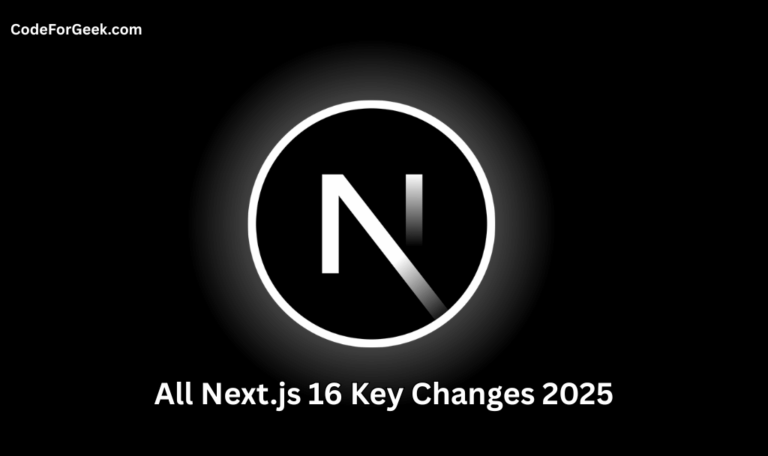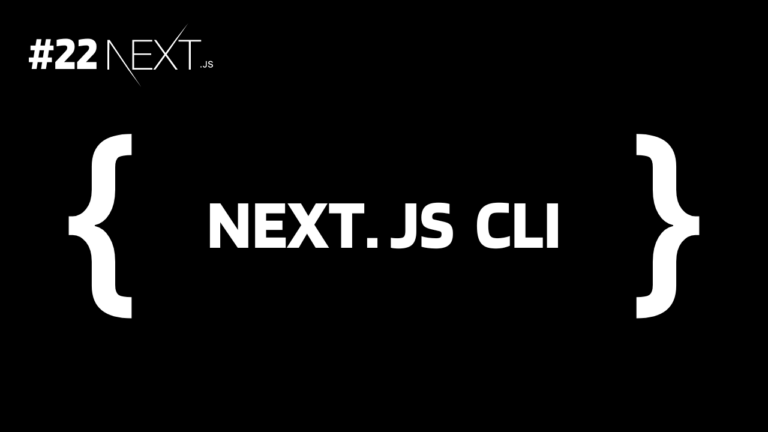You are already familiar with our in-depth Next.js guides, covering everything from React foundations to advanced concepts. Now, by popular demand from our dedicated community, we are providing the one resource you can’t be without: an interview guide built on real-world questions.
Stop wasting time on generic, randomly generated lists. Our guide features only Next.js interview questions that are actually being asked, giving you a true measure of what to expect.
Plus, we have future-proofed your preparation by including key questions that cover the latest changes in Next.js 16, ensuring your knowledge is current for 2026 and beyond. Let’s start.
Understanding Next.js Fundamentals
What is Next.js?
Next.js is a React framework. This means it is a set of tools and rules built on top of the React library. It helps us build powerful, fast, and production-ready web applications much more easily. React gives us the building blocks, but Next.js gives us the full house plans.
What is the difference between Next.js and React.js?
This is a very common question. React is a library that lets us build user interfaces. We can think of it as a box of building blocks. Next.js is a complete framework. It uses React to build the application, but it also gives us a lot of important features that React does not have. This includes things like routing, data fetching, and page rendering, which we would have to build ourselves if we only used React.
What are the key features of Next.js?
Next.js has many key features. The most important ones are file-based routing, which makes creating new pages very easy. It also offers different page rendering options, like server-side rendering and static site generation. It even has API routes, which let us build a simple backend inside our frontend project. It also has great built-in image optimization.
How Next.js Works?
Next.js works by adding structure to our React code. When we create files, Next.js automatically turns them into website routes. It can pre-render our pages, which means it builds the HTML on a server before sending it to the user. This makes the website load very fast. It also bundles all our code and optimizes it for the best performance.
What is Next.js used for?
We use Next.js to build websites that need to be very fast and friendly for search engines (SEO). This makes it a perfect choice for e-commerce stores, marketing websites, landing pages, and blogs. Any application that needs to load quickly and be found on Google is a great fit for Next.js.
Rendering Strategies (SSG, SSR, and ISR)
Describe the differences between SSR, SSG, and client-side rendering (CSR)
We can think about this in a simple way. SSG (Static Site Generation) is like printing a book. The pages are all created once when we build the site. Every reader gets the exact same pre-printed page. This is very fast and great for blogs or company homepages. SSR (Server-Side Rendering) is like asking a chef to make a custom meal. The page is generated on the server for every user who requests it. This is a bit slower than SSG, but it is great for pages that show user-specific data, like a profile page. CSR (Client-Side Rendering) is the traditional React way. The server sends a nearly empty HTML file, and the user’s browser (the client) has to download all the JavaScript to build the page.
What are getStaticProps and getServerSideProps?
These are special functions we use in Next.js to get data for our pages. They connect directly to our rendering strategies. getStaticProps is used for SSG. It runs at build time to get data. The data is then “baked into” the static HTML page. getServerSideProps is used for SSR. It runs on the server every time a user requests the page. This means the data is always fresh.
When would you use SSR over SSG?
This is about choosing the right tool. We should always try to use SSG (with getStaticProps) first because it is much faster. We should only use SSR (with getServerSideProps) when a page must have data that is fresh on every single request. Good examples are a user’s account dashboard or a page showing live stock prices.
What is Incremental Static Regeneration (ISR)?
ISR is a clever mix of SSG and SSR. It lets us use the speed of a static page, but we can also tell Next.js to update it in the background. We set a “revalidate” time, like 60 seconds. The first user gets the old static page, but Next.js will rebuild the page in the background. The next user will then get the new, updated page. This is great for pages that change, but not on every request.
What is meant by pre-rendering in Next.js?
Pre-rendering is the main idea behind Next.js. It means that Next.js generates the HTML for a page before it is sent to the user’s browser. Both SSG and SSR are two different types of pre-rendering. This is the opposite of Client-Side Rendering, and it is the key to Next.js’s great speed and SEO.
What is the difference between getStaticProps and getServerSideProps?
The main difference is when the function runs. getStaticProps runs only once at build time. getServerSideProps runs on every single request on the server. We use getStaticProps for static data and getServerSideProps for dynamic, always-fresh data.
What is client-side rendering, and how does it differ from server-side rendering?
This is a core concept. Server-side rendering (SSR) means the server sends a complete, fully-formed HTML page to the browser. Client-side rendering (CSR) means the server sends a blank HTML shell, and the user’s browser (the client) has to download and run JavaScript to build the page. SSR is faster for the first page load and is much better for search engines to read.
Explain the purpose of the getServerSideProps function.
The purpose of getServerSideProps is to fetch data that is dynamic or specific to a user on every request. It makes sure that the HTML page sent from the server is always populated with the freshest possible data from a database or API.
What are loading strategies in Next.js?
Loading strategies are the different ways we can deliver a page to the user. Our job as developers is to choose the right strategy for each page. The main strategies we can choose from are SSG, SSR, ISR, and CSR. Each one has different benefits for speed and data freshness.
Routing and Navigation in Next.js
How does Next.js handle routing out of the box?
Next.js uses a file-based routing system. This means we do not need to install or configure a separate routing library. We just create files and folders inside the pages directory, and Next.js automatically creates the website routes for us.
What is file-based routing in Next.js?
File-based routing is the system Next.js uses. For example, if we create a file named pages/about.js, Next.js automatically creates a page at the /about URL. If we create pages/blog/first-post.js, it creates a route at /blog/first-post. It is very simple and easy to understand.
How do you implement dynamic routing in Next.js?
We implement dynamic routing by using square brackets in our file names. For example, if we create a file named pages/blog/[slug].js, this one file can handle any route like /blog/post-one or /blog/my-second-article. Inside our component, we can get the value of “slug” to know which post to show.
What is the difference between the Next.js Link component and a regular ‘a’ tag?
This is a very important difference. A regular <a> tag makes the browser do a full page reload. This is slow and loses any application state. The Next.js Link component enables client-side navigation. This means it only loads the parts of the page that have changed, making navigation feel almost instant, like a mobile app.
What is getStaticPaths?
This function works with dynamic routing and SSG. When we have a dynamic page like [slug].js and we want to use SSG, we must tell Next.js which slugs to build at build time. getStaticPaths is the function where we return a list of all the possible slugs (like “post-one”, “post-two”) that Next.js should pre-render.
What is the fallback property in getStaticPaths, and how is it used?
The fallback property tells Next.js what to do if a user requests a slug that was not in our getStaticPaths list. fallback: false means any new slug will show a 404 “not found” page. fallback: true or fallback: 'blocking' will tell Next.js to generate the new page on demand. It then saves this new page so it is static for future requests. This is very useful for large e-commerce sites with thousands of products.
How does Next.js handle client-side navigation?
Next.js handles this using the Link component. When we click a Link, Next.js stops the browser from doing a full-page reload. Instead, it fetches the new page’s code in the background and smoothly swaps the content. This makes the website feel very fast and responsive.
How do you pass data between pages in a Next.js application?
There are a few simple ways. The most common way is to use URL query parameters, like /search?q=my-topic. For more complex data that needs to be shared across many pages, we can use a global state management tool like React Context, or a library like Redux or Zustand.
What are redirects and rewrites in Next.js?
We configure both of these in our next.config.js file. A redirect is a permanent move. If a user visits /old-page, their browser URL changes to /new-page. A rewrite is like a mask. The user visits /products, but Next.js internally shows them the /items page. The user’s browser URL does not change. This is very useful for making cleaner URLs.
Core Files and Practical Configuration
Explain the use of the _app.js file in Next.js.
In the Pages Router, the _app.js file is a special component that wraps every single page in our application. It is the perfect place to put things that all pages share, like a navigation bar, a footer, or global CSS styles.
What is the purpose of the _document.js file?
Also in the Pages Router, the _document.js file is used to customize the main <html> and <body> tags for our entire application. We use it to add things like custom fonts, analytics scripts, or language attributes that need to be in the main document shell.
How do you implement layouts in Next.js?
This depends on which router we are using. In the older Pages Router, we create a layout component and wrap our pages with it inside the _app.js file. In the new App Router, Next.js gives us a special, built-in file named layout.js. We place this file in a folder, and it automatically wraps all pages inside that folder and its child folders.
What is the next.config.js file, and what are some common configurations?
This is the main configuration file for our Next.js project. It is not for React code, it is for our server settings. Common uses are setting up redirects and rewrites, configuring the image optimizer to allow images from other websites, or adding environment variables.
How do you handle static files in Next.js?
Next.js has a special folder named public at the root of our project. Any file we put in this folder, like an image or a font, can be accessed directly from the base URL of our site. For example, a file at public/logo.png can be used in our code at /logo.png.
What is the purpose of the ‘public’ folder?
This is a very similar question. The purpose of the public folder is to serve static assets that do not need to be processed or bundled by Next.js. This is the correct place for files like robots.txt, icons, or images that our HTML needs to reference directly.
How do you handle environment variables in Next.js?
Next.js has great built-in support for environment variables. We create a file named .env.local to store our secret API keys. To make a variable available in the browser, we must start its name with NEXT_PUBLIC_. If we do not add this prefix, the variable will only be available on the server, which is much safer.
How do you add meta tags and titles to pages in Next.js?
Next.js provides a special component called Head from next/head. We can import this component onto any page and put our <title> or <meta> tags inside it. This is very important for SEO because it lets each page have its own unique title and description for search engines.
Building a Backend with API Routes and Middleware
What are API routes in Next.js, and how do you create them?
API routes are a powerful feature that lets us build a simple backend (an API) right inside our Next.js application. We create them by adding files to the pages/api directory. For example, a file at pages/api/hello.js automatically becomes a serverless function that runs at the /api/hello endpoint.
How do API routes work in Next.js?
When we create an API route file, we export a default function (usually called a handler). This function receives a req (request) and res (response) object. This is just like writing in Node.js or Express. We can check the req.method (like GET or POST) to see what the user is trying to do, and then send back a JSON response.
What is Next.js middleware and how is it used?
Middleware is code that runs before a request is completed. It lets us “intercept” a request before it gets to a page or an API route. We can use it for many things, like checking if a user is logged in (authentication), for logging, or to redirect users based on their country.
How do you protect API routes?
A common way to protect API routes is to use middleware. The middleware can check for an authentication token (like a JWT) in the request. If the token is missing or not valid, the middleware can send an “unauthorized” error response before the API route code even runs.
Performance, Optimization, and Styling
How do you optimize performance in a Next.js app?
Next.js gives us many tools. First, we should always choose the fastest rendering strategy for each page (SSG is fastest). Second, we must use the built-in next/image component to optimize our images. Third, we can use the next/script component to control how third-party scripts are loaded. Finally, we can use dynamic imports (next/dynamic) to “lazy load” components that are not needed right away.
How can you optimize images in a Next.js application?
The best way is to always use the built-in next/image component instead of the regular HTML <img> tag. When we do this, Next.js will automatically resize our images for different devices, convert them to modern formats (like WebP), and lazy-load them so they do not slow down the page.
What is the Next.js Image Component?
This is the next/image component. Its purpose is to fix common performance problems caused by images. It prevents us from sending large, unoptimized images to small mobile phones. It also automatically implements lazy loading, which means images only load when the user is about to scroll them into view.
What is the Next.js Script component?
The next/script component gives us smart control over when third-party scripts (like Google Analytics) are loaded. We can tell it to load a script after the page is interactive (strategy="afterInteractive"). This is great because it means the script will not block the page from loading.
What is Hot Module Replacement (HMR) in Next.js?
Hot Module Replacement is a feature for us, the developers. When we are in development mode, if we make a change to our code and save the file, HMR will automatically update the application in our browser without a full page reload. It even keeps our application’s state. This makes the development process much faster.
How can you analyze bundle size?
Next.js provides a tool for this. We can install a package called @next/bundle-analyzer. When we run it with our build, it creates a visual map that shows us exactly which libraries are taking up the most space in our final JavaScript files. This helps us find and remove large or unused code.
How does Next.js handle CSS and styling?
Next.js is very flexible with styling. It has built-in support for several methods. We can use Global CSS by importing a stylesheet in _app.js. The recommended way is CSS Modules, where we name our file [name].module.css and Next.js automatically makes the styles local to that component. It also works perfectly with popular CSS-in-JS libraries like Styled Components.
Advanced Concepts and the Ecosystem
How do you handle errors and error pages in Next.js?
Next.js provides default 404 (not found) and 500 (server error) pages. We can create our own custom, branded error pages by simply creating pages/404.js or pages/500.js files. For errors that happen inside a component, we can use React’s standard “Error Boundaries” to catch them and show a fallback UI.
How would you handle authentication in a Next.js application?
A very popular and recommended way is to use the NextAuth.js library. It is a complete authentication solution built for Next.js. It makes it easy to add social logins (like Google or GitHub) and also email and password (credentials) authentication. It works perfectly with API routes and middleware.
Can you explain how to use TypeScript with Next.js?
Yes, Next.js has excellent, built-in support for TypeScript. To use it, we just create a file named tsconfig.json in our project. Next.js will automatically detect it, install the needed packages, and guide us. After that, we just change our file extensions from .js or .jsx to .ts or .tsx.
What is Styled JSX in Next.js?
Styled JSX is a CSS-in-JS library that was built by the same team that created Next.js. It is built-in, so we do not have to install anything. It allows us to write scoped CSS styles directly inside our React components using a special <style jsx> tag.
Can you use Redux or Zustand in Next.js?
Yes, absolutely. Next.js is still a React application, so we can use any React state management library. We would set up the “Provider” (like the Redux Provider) in the _app.js file (for Pages Router) or a root layout.js (for App Router). This makes our global state available to all pages.
What are some common security considerations when using Next.js?
There are a few key things to remember. First, we must keep our secret keys in the .env.local file and never add the NEXT_PUBLIC_ prefix to them. Second, we must always validate and sanitize any input from users to prevent XSS (Cross-Site Scripting) attacks. Third, we should use tokens and middleware to protect our API routes from unauthorized access.
How do you approach debugging and testing in Next.js applications?
For debugging, we can use console.log on both the server (which shows in our terminal) and the client (which shows in the browser). For testing, we can use Jest and React Testing Library to test individual components. For testing the full application, we can use end-to-end tools like Cypress or Playwright.
What is serverless architecture, and how does it relate to Next.js?
Serverless architecture means we do not have to manage a traditional, always-on server. When we deploy a Next.js app to a platform like Vercel, our API routes and SSR pages are often deployed as serverless functions. This means they only “wake up” and run when they get a request. It scales automatically and we often only pay for what we use.
Conclusion
You now have access to the most current and relevant Next.js interview preparation resource available. By focusing on verified, real-world questions and covering the critical features of Next.js 16, you are equipped to handle any question thrown your way. Good luck!





